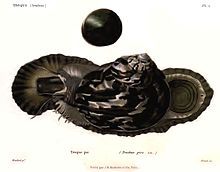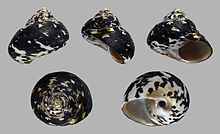Cittarium pica
|
Cittarium pica Temporal range: Pleistocene–Recent |
|
|---|---|
 |
|
| A colored illustration of a live Cittarium pica, showing the inner surface of the operculum at the top | |
 |
|
| Five views of a shell of Cittarium pica | |
| Scientific classification | |
| Kingdom: | Animalia |
| Phylum: | Mollusca |
| Class: | Gastropoda |
| Clade: | Vetigastropoda |
| Superfamily: | Trochoidea |
| Family: | Tegulidae |
| Genus: | Cittarium |
| Species: | C. pica |
| Binomial name | |
|
Cittarium pica (Linnaeus, 1758) |
|
| Synonyms | |
Cittarium pica, common name the West Indian top shell or magpie shell, is a species of large edible sea snail, a marine gastropod mollusk in the family Tegulidae. This species has a large black and white shell.
This snail is known as "wilk" or "wilks" (or sometimes as "whelks") in the English-speaking Caribbean islands of the West Indies, where this is a popular food item. The word "will" or "wilks" can used both as a singular form and a plural. This species is however not at all closely related to the species that are known as whelks in the U.S. and in Europe. In some Spanish-speaking parts of the Caribbean, when used as a food source Cittarium pica is known as bulgao, or simply as caracoles (snails, in Spanish). In Venezuela it is called quigua; in Cuba it is called cigua.
Cittarium pica is considered the third most economically important invertebrate species in the Caribbean, after the spiny lobster (Panulirus argus) and the queen conch (Eustrombus gigas). It has gone locally extinct in some habitats due to overfishing and overexploitation.
Cittarium pica is within the clade Vetigastropoda. The vetigastropods are considered to be among the most primitive living gastropods, and are widely distributed in all oceans of the world. It is also part of the superfamily Trochoidea, presenting nacre as the inner shell layer, and its subordinated family Tegulidae. Woodring et al. (1924) recombined this species as Cittarium picum. Weisbord (1962) recombined it as Livona pica, and it was finally recombined as Cittarium pica by Philippi (1847), Rosenberg (2005) and Hendy et al. (2008).
...
Wikipedia
